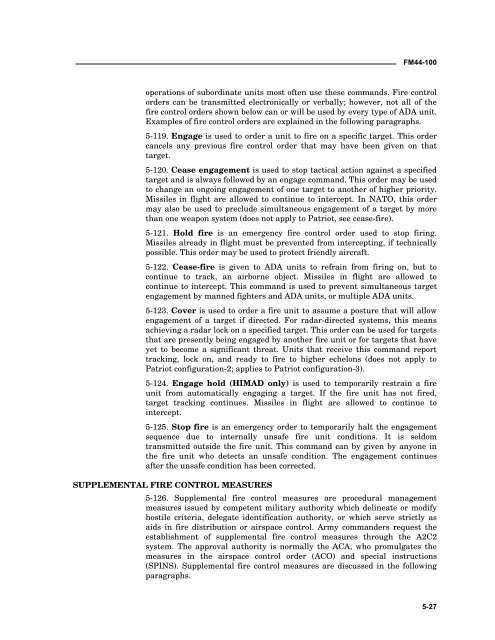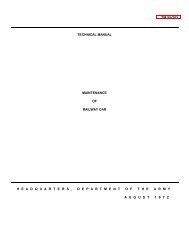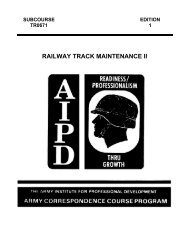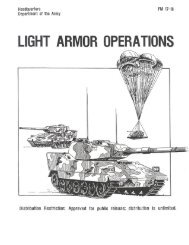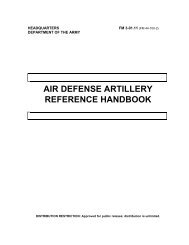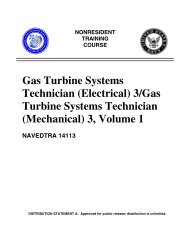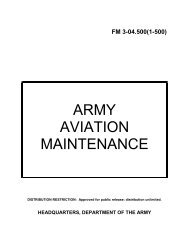fm 44-100 us army air and missile defense operations
fm 44-100 us army air and missile defense operations
fm 44-100 us army air and missile defense operations
Create successful ePaper yourself
Turn your PDF publications into a flip-book with our unique Google optimized e-Paper software.
FM<strong>44</strong>-<strong>100</strong><br />
<strong>operations</strong> of subordinate units most often <strong>us</strong>e these comm<strong>and</strong>s. Fire control<br />
orders can be transmitted electronically or verbally; however, not all of the<br />
fire control orders shown below can or will be <strong>us</strong>ed by every type of ADA unit.<br />
Examples of fire control orders are explained in the following paragraphs.<br />
5-119. Engage is <strong>us</strong>ed to order a unit to fire on a specific target. This order<br />
cancels any previo<strong>us</strong> fire control order that may have been given on that<br />
target.<br />
5-120. Cease engagement is <strong>us</strong>ed to stop tactical action against a specified<br />
target <strong>and</strong> is always followed by an engage comm<strong>and</strong>. This order may be <strong>us</strong>ed<br />
to change an ongoing engagement of one target to another of higher priority.<br />
Missiles in flight are allowed to continue to intercept. In NATO, this order<br />
may also be <strong>us</strong>ed to preclude simultaneo<strong>us</strong> engagement of a target by more<br />
than one weapon system (does not apply to Patriot, see cease-fire).<br />
5-121. Hold fire is an emergency fire control order <strong>us</strong>ed to stop firing.<br />
Missiles already in flight m<strong>us</strong>t be prevented from intercepting, if technically<br />
possible. This order may be <strong>us</strong>ed to protect friendly <strong>air</strong>craft.<br />
5-122. Cease-fire is given to ADA units to refrain from firing on, but to<br />
continue to track, an <strong>air</strong>borne object. Missiles in flight are allowed to<br />
continue to intercept. This comm<strong>and</strong> is <strong>us</strong>ed to prevent simultaneo<strong>us</strong> target<br />
engagement by manned fighters <strong>and</strong> ADA units, or multiple ADA units.<br />
5-123. Cover is <strong>us</strong>ed to order a fire unit to assume a posture that will allow<br />
engagement of a target if directed. For radar-directed systems, this means<br />
achieving a radar lock on a specified target. This order can be <strong>us</strong>ed for targets<br />
that are presently being engaged by another fire unit or for targets that have<br />
yet to become a significant threat. Units that receive this comm<strong>and</strong> report<br />
tracking, lock on, <strong>and</strong> ready to fire to higher echelons (does not apply to<br />
Patriot configuration-2; applies to Patriot configuration-3).<br />
5-124. Engage hold (HIMAD only) is <strong>us</strong>ed to temporarily restrain a fire<br />
unit from automatically engaging a target. If the fire unit has not fired,<br />
target tracking continues. Missiles in flight are allowed to continue to<br />
intercept.<br />
5-125. Stop fire is an emergency order to temporarily halt the engagement<br />
sequence due to internally unsafe fire unit conditions. It is seldom<br />
transmitted outside the fire unit. This comm<strong>and</strong> can by given by anyone in<br />
the fire unit who detects an unsafe condition. The engagement continues<br />
after the unsafe condition has been corrected.<br />
SUPPLEMENTAL FIRE CONTROL MEASURES<br />
5-126. Supplemental fire control measures are procedural management<br />
measures issued by competent military authority which delineate or modify<br />
hostile criteria, delegate identification authority, or which serve strictly as<br />
aids in fire distribution or <strong>air</strong>space control. Army comm<strong>and</strong>ers request the<br />
establishment of supplemental fire control measures through the A2C2<br />
system. The approval authority is normally the ACA, who promulgates the<br />
measures in the <strong>air</strong>space control order (ACO) <strong>and</strong> special instructions<br />
(SPINS). Supplemental fire control measures are disc<strong>us</strong>sed in the following<br />
paragraphs.<br />
5-27


